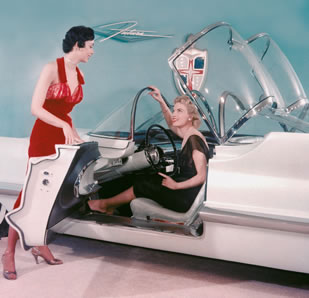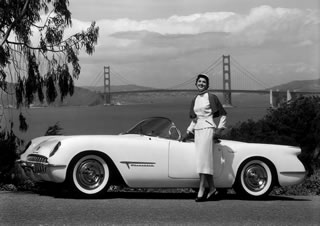Adventure on Wheels - Page 4
In the early '50s, designer Chuck Jordan recalled, Earl was telling his men, "Design cars that are longer, lower, wider."
Through his work on cars, Earl is considered one of America's most influential designers ever. But others played major roles as well. And it is important to remember that car design was a collaborative process involving dozens of designers and clay modelers.
 |
 |
|
|
Virgil Exner (1909-1973), who began his career at GM under Earl, then worked for Studebaker, Ford, and Chrysler, exerted his will as well on the American car of the '50s—to very different effect than Earl.
His cars tended to be simpler and less ornate, emphasizing "simple, classic surfaces with minimal ornamentation, accentuating functional elements of the car instead of hiding them—elements like the wheels, radiator grille, spare tire, and lights," according to Grist, author of 'Virgil Exner: Visioneer.'
But Exner too could produce cars that were wildly exuberant, as the market demanded.
One of his classic designs was the 1960 Plymouth XNR—and also one of his most personal, as you can see by deciphering its name. This two-seat racer had a remarkable asymmetric design.
1950s cars weren't always outrageous. They could be comfy too. Consider the Chevrolet Bel-Air, one of the decade's iconic cars—box-like yet curvaceous, two-toned yet subtle, chrome-trimmed yet sophisticated, aerodynamic yet roomy.
 |
 |
|
|
This was a car you could spend hours in, even days—designed for people who ate at drive-in restaurants, caught double-bills at drive-in theaters, did their errands at strip shopping centers, and enjoyed vacations along the nation's new Interstates.
Dream cars did more than explore innovative technologies. They kept the public excited about cars. Motoramas were more than car shows.
They were multi-media, mind-blowing blitzes with music, dancing, hot girls, and hot cars.
Some of the most iconic cars of the era premiered at the Motoramas, including the Chevrolet Corvette, a concept car in 1953, put into production within months to become, with Ford's Thunderbird, one of the most popular American sports cars.
Earl, who had a thing for rocket ships and jets, oversaw production of many dream cars that seemed bound for Mars more than for the open road. The GM turbine-powered Firebirds from the 1950s are astounding creations, technically and artistically. The '54 Firebird XP-21 is a jet on wheels.
The titanium Firebird III, from 1958, with multiple tail and side fins, used sensors to create a driver-less vehicle—or tried to, at any rate, an effort still going on today.
Ford aimed for the stratosphere as well. The two-toned, glass-domed 1955 concept car Ford Mystere—a lovely name—replaced its steering wheel with a joystick.
 |
|
|
Other '50s space-age Fords include the 1953 Ford XL-500, with its fiberglass body and all-glass cab that came with both a phone and a Dictaphone.
The Ford FX Atmos (FX stood for 'future experimental'), from a year later, also had a bubble top, a handgrip for control rather than a steering wheel, plus wild shark fins. And in 1961, George Walker, Ford's vice president for styling, turned out the Gyron, which ran on two wheels, stabilized with a gyroscope.
Both Ford and Chrysler built some of their most expressive concept cars with the Italian firm Ghia, which was known for superior craftsmanship.




